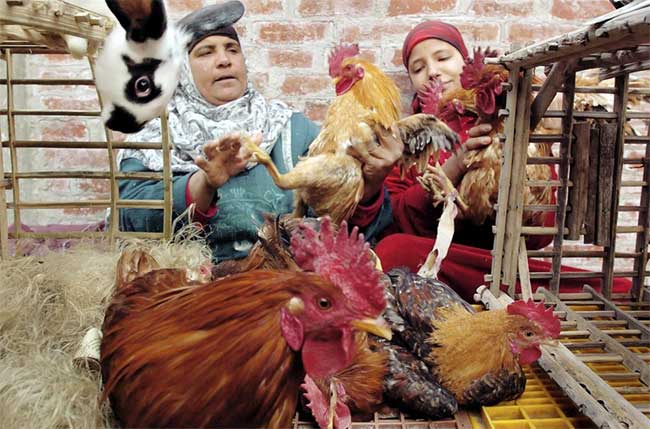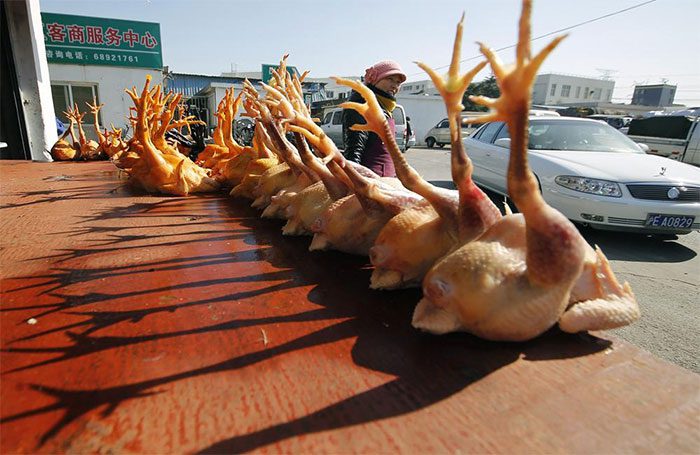Avian Influenza Has Spread to New Locations Worldwide Outbreaks of the avian influenza virus have been reported in North America, South America, Europe, Asia, and Africa. They do not “submit” to the heat of summer or the bitter cold of winter.
The Reuters news agency engaged with over 20 experts and farmers across four continents, who believe that the prevalence of the avian influenza virus in nature indicates that outbreaks are unlikely to diminish soon on poultry farms.

A chicken vendor in Tanta, Egypt. (Photo: AP).
This escalates the threat to the world’s food supply. They warn that farmers must regard this disease as a serious risk year-round, rather than only focusing their preventive efforts during spring—the migration season for wild birds.
The strain of the virus that reached the United States in early 2022 is genetically similar to cases in Europe and Asia. The total number of birds that died in the U.S. in 2022 reached 58 million. This virus is often fatal to poultry. Entire flocks are usually culled if just one bird tests positive. Vaccination is not a simple solution: it can reduce but not eliminate the threat from the virus.
On February 15, Argentina and Uruguay declared a national health emergency after officials confirmed the first cases of infection in these two countries. Argentina detected the virus in wild birds, while dead swans in Uruguay tested positive for the avian influenza virus.
The U.S., U.K., France, and Japan are among the countries that suffered record poultry losses last year, leaving some farmers feeling helpless. “Avian influenza occurs even in new farms equipped with modern technology and without windows, so all we can do now is pray for God to stop the outbreak,” shared Shigeo Inaba, a broiler chicken farmer in Ibaraki Prefecture, Japan.
Egg prices hit record highs after the avian influenza outbreak in 2022 led to the death of tens of millions of hens. This situation hampers some of the world’s poorest countries from accessing eggs—a cheap protein source at a time when the global economy is struggling with high inflation. Experts say wild birds are primarily responsible for spreading the virus. Waterfowl, such as ducks, can carry the disease without dying and transmit it to poultry.
Experts indicate that high levels of the virus in many types of waterfowl and wild birds mean that poultry now faces a high risk year-round. Veterinarian Bret Marsh in Indiana, U.S. remarked: “It’s a new battle.”
Gregorio Torres from the World Organisation for Animal Health based in Paris, France, stated that wild birds have spread the disease further and wider than ever before, capable of carrying record amounts of the virus. Torres told Reuters that this virus has evolved from previous outbreaks into a form that is more transmissible.
Torres could not confirm whether avian influenza is endemic among wild birds worldwide, although other experts indicated it is endemic in some bird species in places like the U.S. The World Health Organization (WHO) stated that the risk to humans is low.
David Suarez from the U.S. government’s Southeastern Poultry Research Laboratory mentioned that the circulating strain of the virus infects more wild bird species than previous versions, including those that do not migrate far. He said: “The infection of such ‘resident’ birds is helping the virus persist year-round, which was not the case before.”
Some experts suspect that climate change may have contributed to the global spread of avian influenza as the migration routes and habitats of wild birds change.
David Stallknecht from the University of Georgia, U.S. noted that black vultures living in the southern U.S. that previously avoided the disease are now among those affected. The virus has also infected mammals such as foxes, bears, and seals.

Chicken for sale at a market in Shanghai, China. (Photo: AP).
Stallknecht stated that high virus concentrations in birds such as blue-winged teal and long-distance migratory ducks have spread the virus to new regions of South America. Countries including Peru, Ecuador, and Bolivia have reported their first cases in recent months.
The Ecuadorian Ministry of Agriculture and Livestock declared a three-month animal health emergency on November 29, 2022, two days after the first case was detected. The agency reported that to date, over 1.1 million poultry have died.
Avian influenza cases in Uruguay and Bolivia have brought the disease closer to the border of Brazil, the world’s leading chicken meat exporter. Brazilian Agriculture Minister Carlos Favaro stated on February 15 that the country is investigating three suspected cases, but test results came back negative. Gian Carlos Zacchi, a chicken farmer in Chapecó, Santa Catarina (Brazil), remarked: “Everyone is focused on preventing the flu from entering our country.”
Farmers Are Trying Unusual Strategies to Protect Poultry, with some using machinery that emits loud noises to scare away wild birds. In Rhode Island, U.S., egg producer Eli Berkowitz has sprayed Lysol disinfectant on goose droppings along the pathways of his farm to prevent potential virus contamination. He has also limited visitors to the farm. Berkowitz mentioned he is preparing for March and April when the migration season will pose a greater risk to poultry.


















































